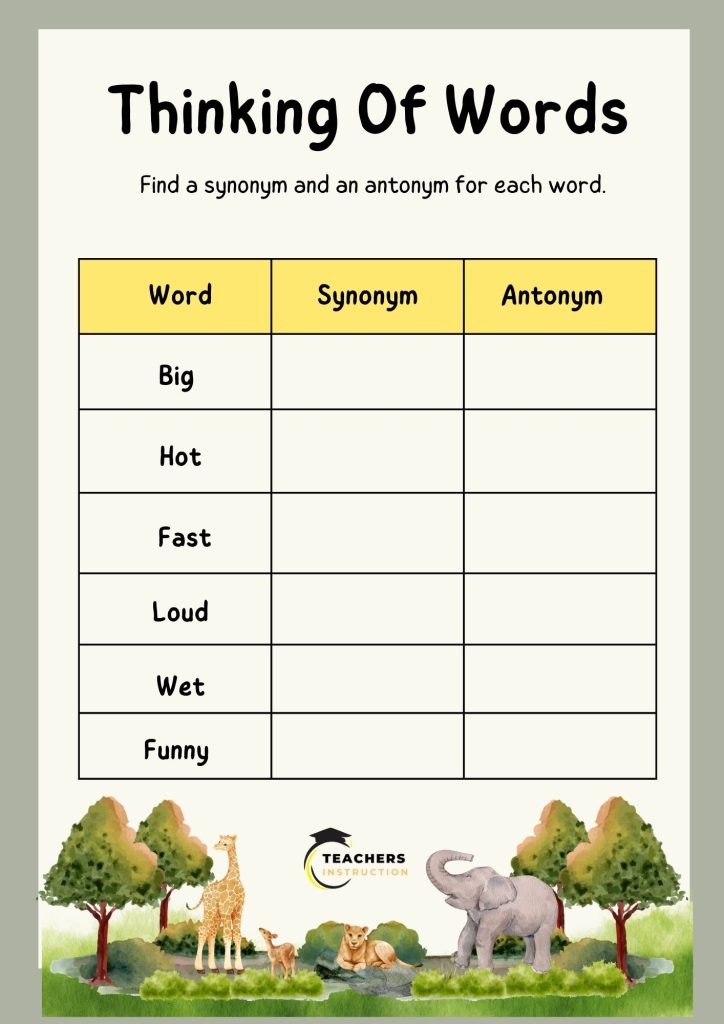Language is a wondrous tapestry woven with words, each thread contributing to the rich fabric of communication. Within this vast lexicon, synonyms and antonyms stand as essential elements, shaping the nuances and subtleties of expression. Understanding these linguistic companions not only enhances our vocabulary but also empowers us to wield language with precision and artistry.
In this blog post, we embark on a journey into synonyms and antonyms through an interactive synonym and antonym worksheet guide. Whether you’re a student eager to expand your linguistic repertoire or a teacher seeking creative resources for the classroom, this comprehensive worksheet offers a treasure trove of learning opportunities.
Join us as we delve into the world of words, uncovering the intricacies of synonymy and antonymy, and unlocking the doors to clearer communication and deeper understanding. Let’s embark on this enlightening exploration together, where every word becomes a stepping stone toward mastery of language.
Synonyms
Synonyms are words that have similar meanings. They play an essential role in enriching our language, providing variety in expression, and enhancing communication. Understanding synonyms helps us to convey our thoughts more precisely and effectively.
Definition: A synonym is a word that shares a similar meaning with another word. These words may differ in spelling and pronunciation but can be used interchangeably in many contexts to convey the same or similar idea or concept.
Examples:
- “Happy” and “joyful” are synonyms because they both express a feeling of pleasure or contentment.
- “Big” and “large” are synonyms as they both describe something of considerable size.
- “Fast” and “quick” are synonyms, indicating rapid speed or action.
Importance of Synonyms:
- Enhance Vocabulary: Learning synonyms expands vocabulary and helps in articulating thoughts more precisely.
- Effective Communication: Synonyms provide variety and depth to language, making communication more engaging and impactful.
- Avoid Repetition: Instead of repeating the same word multiple times, synonyms offer alternatives to keep the language interesting.
- Understanding Context: Recognizing synonyms aids in understanding context and nuances in written and spoken language.
- Writing and Speaking Skills: Mastery of synonyms improves writing and speaking skills by enabling individuals to choose the most appropriate words for expression.
Antonyms
Antonyms are pairs of words that have opposite meanings. They provide contrast and clarity in language, allowing speakers and writers to convey ideas more precisely. Antonyms are essential for expressing nuances in meaning and for adding depth to communication.
Examples of Antonyms:
- Simple and Complex: “Simple” and “complex” are antonyms. They describe opposite levels of difficulty or complexity. For instance, a task can be either simple or complex, depending on its level of intricacy.
- Love and Hate: “Love” and “hate” are antonyms that represent opposite emotions. Love involves affection, fondness, and warmth, while hate entails strong dislike, animosity, and hostility.
- Fast and Slow: “Fast” and “slow” are antonyms used to describe speed or pace. Something can be fast-moving or slow-moving, indicating contrasting rates of motion.
- Big and Small: “Big” and “small” are antonyms that describe size. They indicate opposite ends of the spectrum in terms of magnitude or dimensions.
- Hot and Cold: “Hot” and “cold” are antonyms related to temperature. They represent opposite extremes of thermal sensation, with “hot” indicating high temperature and “cold” indicating low temperature.
Importance of Antonyms:
- Clarity and Precision: Antonyms help in clarifying meanings by contrasting concepts. They provide a clear understanding of the intended message by highlighting differences.
- Enhanced Vocabulary: Learning antonyms expands vocabulary and language proficiency. It allows individuals to express ideas with greater precision and variety.
- Effective Communication: Antonyms add depth and richness to communication. By using antonyms appropriately, speakers and writers can convey subtle shades of meaning and evoke specific emotions.
- Critical Thinking: Recognizing antonyms requires critical thinking skills. It involves understanding the context and identifying contrasting elements within language, which fosters cognitive development.
- Literary and Poetic Devices: Antonyms are frequently used in literature and poetry to create contrast, emphasize themes, and evoke imagery. They contribute to the artistic expression and aesthetic appeal of language.
Synonym Antonym Worksheet Grade 01 – ESL
Print this image and write their correct synonyms and antonyms.

Here’s a simple table with 10 easy words along with their synonyms and antonyms:
| Word | Synonym | Antonym |
|---|---|---|
| Happy | Joyful | Sad |
| Big | Large | Small |
| Hot | Warm | Cold |
| Fast | Quick | Slow |
| Bright | Shiny | Dim |
| Funny | Hilarious | Serious |
| Brave | Courageous | Cowardly |
| Loud | Noisy | Quiet |
| Wet | Moist | Dry |
| Kind | Compassionate | Mean |
Conclusion
In conclusion, the journey through synonym and antonym worksheets has been both enlightening and enriching. By delving into the intricacies of language, learners have honed their vocabulary, sharpened their communication skills, and gained a deeper appreciation for the power of words. These worksheets serve as invaluable tools, fostering creativity, critical thinking, and linguistic mastery. As students complete exercises, they expand their lexicon and enhance their ability to express ideas with clarity and precision. With each synonym and antonym explored, learners embark on a path toward greater fluency and confidence in the fascinating world of language.
